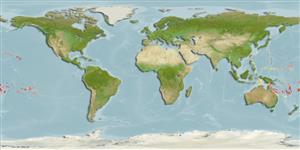Common names from other countries
Environment: milieu / climate zone / depth range / distribution range
Écologie
. Tropical
Pacific Ocean: from Tonga (and possibly Fiji) islands to eastern Polynesia; Philippines.
Length at first maturity / Taille / Poids / Âge
Maturity: Lm ? range ? - ? cm Max length : 9.0 cm SHL mâle / non sexé; (Ref. 349); common length : 6.5 cm SHL mâle / non sexé; (Ref. 349)
Found on sheltered rock platforms of coral reefs, occasionally on the exposed algal crests. Shallow subtidal waters. Active at night (Ref. 349).
Life cycle and mating behavior
Maturité | Reproduction | Frai | Œufs | Fécondité | Larves
Members of the order Neotaenioglossa are mostly gonochoric and broadcast spawners. Life cycle: Embryos develop into planktonic trocophore larvae and later into juvenile veligers before becoming fully grown adults.
Poutiers, J.M. 1998. (Ref. 349)
Statut dans la liste rouge de l'IUCN (Ref. 130435)
statut CITES (Ref. 108899)
Not Evaluated
Not Evaluated
Menace pour l'homme
Harmless
Utilisations par l'homme
Pêcheries: commercial
| FishSource |
Outils
Plus d'informations
Taille/ÂgeCroissanceLongueur-poidsLongueur-longueurMorphologieLarvesAbondance
Sources Internet
Estimates based on models
Vulnérabilité
Low vulnerability (10 of 100).
Catégorie de prix
Unknown.
